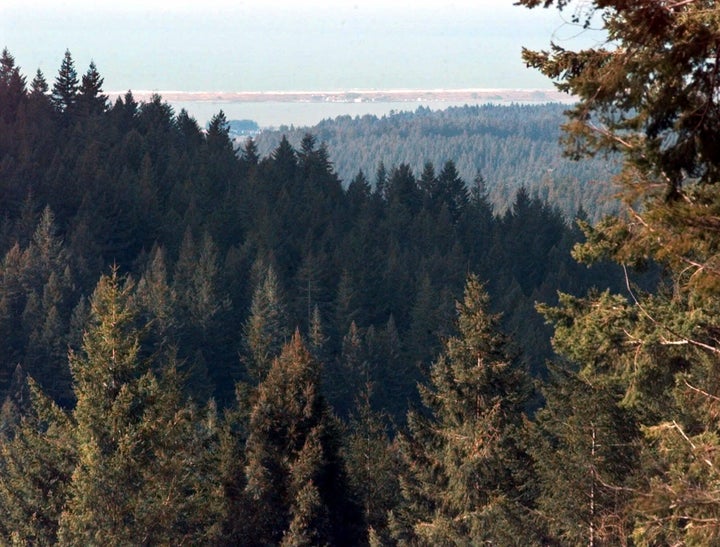
Imagine the most perfect tree on Earth: one that out does all others in magnificence, size, height, productivity, architecture, ability to draw thousands of gallons of water, yet marvelously resist drought, fire, insects, disease, mudslides, flooding, wind; and they possess exquisite biodiversity in their crowns. Then, and only then, as John Muir put it, "you'd know the king of their race" -- the immortal Sequoia sempervirens, otherwise know as the coastal redwood.
Coastal redwoods direct lineage can be traced back to 144 million years ago to the beginning of the Cretaceous period. At the time when Tyrannosaurus rex was beginning to rule for over 40 million years as no reptile nor animal has ever achieved since. Redwoods belong to the plant group known as Taxodaciae and they were the most widespread of all conifers inhabiting planet Earth.
Redwoods are considered unique for many reasons. They are able to reproduce from both seed and a lignotuberous organ at the base of the tree just beneath the soil. No other conifer possesses this dual mechanism -- shooting roots from its base; a trait that is widespread amongst the more advanced race of trees called angiosperms (broadleaf trees) evolving some 80 million years after redwoods were born. The angiospersms or broadleaved trees owe their existence to pollinators -- like bees, moths, bats and birds.
The tallest living tree on planet Earth is a coastal redwood at 379.3 feet, called Hyperion. That's twice the size of the Statue of Liberty or the equivalent of a 38-story skyscraper. That tree was probably born at the time Jesus Christ walked the Earth. It carries well over 1 billion needles enough to cover an entire football field.
Redwoods store thousands of gallons of water, so in the dry summer months they never run out and consequently they probably grow 11 months but probably 12 months of the year. The wood doesn't contain gooey pitch like pines, firs, spruces and larches and so it doesn't burn easily. The 20-inch or thicker bark is an excellent insulator -- in the north of its range fire frequencies are in the order of 600 to 800 year events. The bark is high in tannic acid and the wood is filled with volatile essential oils which make it very rot resistant. Though insects do infest redwoods, none can singularly kill mature trees.
Coastal redwoods have survived climate changes, geologic upheavals and ice ages. Today they exist only along a narrow strip of land of about 435 miles long reaching from southwest Oregon to the Big Sur. There are three distinct populations: northern, central and southerly.
They have adaptations enabling them to live at least a couple thousand years. Redwoods have the ability to suck water out of fog so that during summer dry periods they can continue to grow. Their roots have -- as all trees have -- a partnership with a soil fungus called mycorrhizas whereby the fungus feeds on the sugars of the tree root and in return provides additional moisture and nutrients for the roots. The particular mycorrhizae that associates itself with redwoods also confers drought resistance to redwood roots. Just in case an unforeseen prolonged dry spell sets in.
The real story occurs way up in the tree-tops. Redwoods can sprout a forest above a forest -- scientists think that this is in response to mechanical damage and to seek more available light needed to be captured to make more food.
Branch to branch, branch to trunk and trunk-to-trunk fusions are common in many of the ancient northerly trees. These become sources to store and share water and nutrients and they stabilize the crown during winter storms. These forest's above forests promote biodiversity.
In the tree-tops, there are 500-year-old saturated fern mats (small lakes) the size of large mini-vans weighing over 551 pounds. Banff and Los Angeles-based conservation institute Global Forest Science along with scientists from Humboldt State University have found aquatic copepods (miniature fresh-water critters) some 230 feet above the Earth living in the moss fern-mat lakes. Prior to their discovery these critters were only know to live in the stream beds on the forest floor. Scientists believe that they crawled some 230 feet up the rain-drenched trunks during the winter months -- the human equivalent would be to crawl up Mt. Everest!
These ancient redwood forests and their tree-tops support myriad lichens, bryophytes and mosses as well as other vascular plants like salmonberry, huckleberry and Rhamnus trees growing some 240 feet above the earth.
These canopies or tree-tops are also home to endangered animals like spotted owls -- each breeding pair requires at least 2,500 acres of undisturbed forest to successfully breed and they are being dislodged by baird owls. The endangered marbles murrelet, that was only discovered in 1974, that can fly at speeds in excess of 85 miles per hour and lives at sea for up to 9 months, coming ashore only to breed on moss draped branches in the ancient redwood forests.
Redwoods are quite simply the most productive ecosystems on Earth, producing a staggering 4,500 cubic meters of wood per acre.
There are only .007 percent of huge ancient redwoods ecosystems remaining. The world is a very different place today from when the Taxodiacea were one of the most broadly distributed group of plants on earth. Tyrannosaurus is gone, but the redwoods remain. Barely.
Although the extinction of the coast redwood species in the near future is doubtful, the sensitivity of the redwood ecosystem is undeniable. Global warming is beginning to bite into these forests too; it's reducing the number of hours of fog by three hours a day, and in the hot, dry summer -- missing fog is a significant factor impinging upon tree health, longevity and ultimately the distribution of this species.
Conservation biologists must be given the opportunity to study and understand these magnificent forests. Their health and longevity will undoubtedly benefit all humankind. Therefore, a moratorium on all future logging in any ancient remaining redwoods is of paramount importance.
Dr Reese Halter is a Science Communicator: Voice for Ecology, conservation biologist at California Lutheran University and public speaker. His latest book is The Incomparable Honeybee. Contact him through www.DrReese.com.
